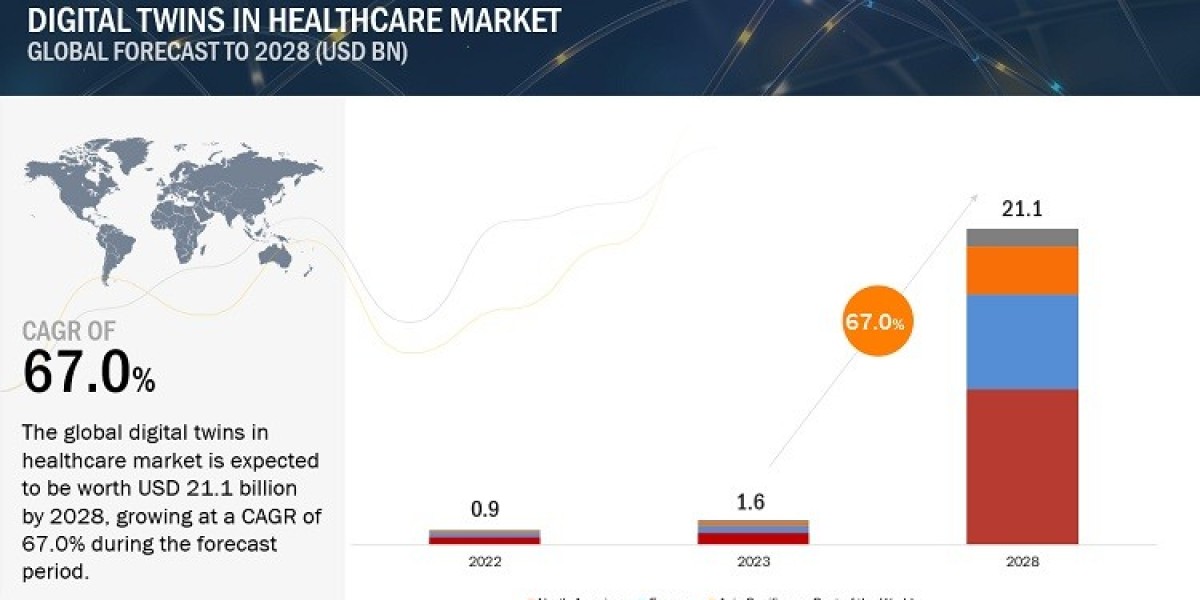Introduction
The healthcare industry is undergoing a paradigm shift driven by technological advancements, with digital twins playing a pivotal role. Digital twins — virtual replicas of physical healthcare processes, devices, or human bodies — are revolutionizing patient care, predictive analytics, and operational efficiency. This blog explores key trends, growth drivers, and market opportunities within the Digital Twins in Healthcare Market.
What are Digital Twins in Healthcare?
Digital twins are virtual representations of real-world healthcare entities, processes, or systems. Powered by IoT, AI, and big data, these digital counterparts allow healthcare providers to simulate scenarios, test outcomes, and make real-time adjustments to patient care or operations.
Use Cases of Digital Twins in Healthcare
- Personalized Medicine: Tailored treatment plans for patients using patient-specific twin models.
- Drug Discovery: Simulations to predict drug efficacy and toxicity, reducing R&D timelines.
- Surgical Training & Medical Education: Virtual environments to practice surgeries and learn medical procedures.
- Predictive Maintenance for Medical Devices: Identifying potential equipment failures before they occur, reducing downtime.
The integration of healthcare digital twins with AI and IoT is one of the major factors propelling market growth.
Market Growth Drivers for Digital Twins in Healthcare
The Digital Twins in Healthcare Market is poised for remarkable growth. Here are the main factors driving its expansion:
- Technological Advancements
AI, IoT, and cloud-based platforms are making healthcare twins more accessible and cost-effective. These technologies enable real-time simulation, predictive modeling, and remote monitoring, leading to better patient outcomes.
- Rise in Personalized Medicine
The growing demand for personalized healthcare is encouraging the adoption of digital twins. By creating digital replicas of individual patients, healthcare providers can simulate disease progression, test treatment strategies, and offer more targeted therapies.
- Operational Efficiency
Healthcare providers are under pressure to optimize workflow, reduce costs, and improve patient experience. Digital twins facilitate predictive maintenance of medical devices, optimize patient flow, and enhance the scheduling of operating rooms and medical staff.
- Growing Role of Predictive Analytics
Predictive analytics using AI and machine learning is being integrated with digital twins to foresee operational issues, patient risks, and disease outbreaks. Hospitals can better allocate resources, prevent overcrowding, and reduce patient wait times.
- Cost Reduction & R&D Acceleration
Digital twins support drug discovery and clinical trials, allowing pharmaceutical companies to reduce research timelines. Simulating drug interactions and patient responses reduces reliance on traditional trials, accelerating time-to-market for new therapies.
Key Market Trends for 2024 and Beyond
The following trends are shaping the future of the Digital Twins in Healthcare Market:
- Greater Integration with AI and IoT
Advanced AI-driven models are creating more accurate digital twins. By integrating IoT devices like wearable health monitors, patient-specific data is constantly fed into the twin, allowing for personalized treatment.
- Shift Toward Predictive Care
Healthcare providers are shifting from reactive care to predictive care models. Digital twins enable healthcare facilities to predict patient needs, preempt issues, and improve patient flow.
- Emphasis on Data Interoperability
Healthcare organizations are embracing open data standards to enhance interoperability. Digital twins rely on shared, real-time data from medical devices, patient records, and IoT sensors to achieve full potential.
- Rise of Cloud-Based Healthcare Twins
Cloud-based platforms are enabling healthcare providers to access digital twins remotely. This allows for telehealth services, remote device monitoring, and AI-assisted clinical support.
Industry Opportunities for Stakeholders
The rising adoption of digital twins presents a range of opportunities for key stakeholders:
- Healthcare Providers: Leverage digital twins to reduce costs, improve operational efficiency, and deliver personalized medicine.
- Pharmaceutical Companies: Use digital twins for drug discovery and accelerated clinical trials, thereby reducing R&D costs.
- Medical Device Manufacturers: Use predictive maintenance for medical devices, ensuring better device uptime and reduced operational disruptions.
- Investors and Tech Firms: Develop AI-driven platforms for healthcare twin simulation, predictive analytics, and workflow optimization.
How to Capitalize on the Market Opportunities?
Industry stakeholders can capitalize on the opportunities in the Digital Twins in Healthcare Market by focusing on the following actions:
- Adopt Cloud-Driven Twins: Cloud-based platforms offer cost-effective, scalable solutions.
- Invest in Predictive Analytics: Use predictive insights to optimize workflow, improve patient experiences, and reduce operational costs.
- Collaborate with Tech Providers: Partner with technology firms offering advanced AI and IoT solutions.
- Develop Interoperable Solutions: Prioritize systems that integrate with existing healthcare platforms to ensure seamless data sharing.
Future Outlook for the Digital Twins in Healthcare Market
As healthcare organizations increasingly turn to predictive and personalized care models, the role of digital twins will become indispensable. The market is expected to grow significantly, with major growth areas being personalized medicine, surgical planning, and medical device maintenance. Key players like GE and Siemens are driving innovation, while new entrants are introducing agile, cloud-based platforms to make the technology more accessible.
Conclusion
The Digital Twins in Healthcare Market is undergoing rapid transformation, driven by technological advances and growing demand for personalized care. By integrating AI, IoT, and cloud-based platforms, healthcare providers can enhance patient care, reduce costs, and improve operational efficiency. Stakeholders in this market — from healthcare providers to tech firms — should focus on interoperability, predictive analytics, and cloud adoption to remain competitive.
Naijamatta is a social networking site,
download Naijamatta from Google play store or visit www.naijamatta.com to register. You can post, comment, do voice and video call, join and open group, go live etc. Join Naijamatta family, the Green app.
Click To Download

